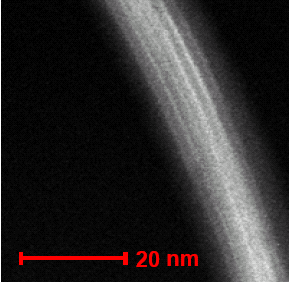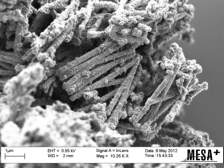The LT group on Biomagnetism in collaboaration with the SMCT group take part in a european Research and Training Network (RTN). The name of this RTN is ‘CARBIO’ and it is designed to exploit the potential of multi-functional carbon nanotubes (CNT) for biomedical applications, in particular to act as magnetic nano-heaters, drug-carrier systems and sensors which allow a diagnostic and therapeutic usage on a cellular level. (for more information see: http://www.carbio.eu/)
A broad multidisciplinary approach will be applied ranging from basic research in chemistry, physics and biology to biophysical, biochemical and medical studies. To be specific, we want to:
- Synthesize CNT with tailored functionalities (different filling, heat sensitive caps)
- Modify them in order to become compatible to actual biological systems
- Study their chemical and physical properties in order to find mechanisms, which can be applied for a certain biomedical purpose in appropriate medical devices
- Study their interaction with biological environments (immune response, toxicity, interaction with the single cell)
- Apply them for imaging (nanoparticles-based contrast agents), sensoring (nanoparticles-based diagnostics) and cancer treatment (hyperthermia, nanotechnology-based targeted drug delivery)

Dark field image of a Fe-filled single-wall CNT.
On the basis of this multidisciplinary problem, early-stage researchers will be trained to apply the variety of state-of-the-art techniques covering all aspects of experimental biomedical nanoscience. Additional local and network-wide training activities, training in complementary skills dedicated to research in biomedical nanoscience (ethical and safety aspects, patents etc.), and a cooperation with industrial partners will guarantee the complete education of early-stage researchers in this innovative and expanding field of applied science.
Current state of research
Ir. Martin Sobik
Carbon nanotubes (CNTs) are quasi-one-dimensional nanoparticles that are foreseen as potential multifunctional tools for future biomedical applications (probes for biomolecule detection in biological fluids, cells, tissues, etc…). When filled with metallic Fe, CNTs (Fig. 1) can potentially be used for imaging and sensoring due to their shape anisotropy. Imaging and sensoring of ferromagnetic CNTs is the main activity of my PhD.

Fig. 1 Functionalised Carbon Nanotube with various filling and functional groups
Prior to this work, functionalisation of Fe-CNTs is achieved in order to render them dispersible in acqueous based solutions and biologically compatible. We study various properties of as produced Fe-CNTs highly stable colloidal suspensions as well as their fundamental magnetic properties using vibrating sample magnetometers.
In a second step, spatially resolved SQUID studies are performed on individual Fe-CNTs. A Scanning SQUID Microscope is used to localise individual Fe-CNTs in various media (solid state substrate, phantoms, cells…) with a high spatial resolution at 5 K. In addition, various gradiometers are used to localise but more specifically to quantify the Fe-CNTs distributed on a larger scale in phantoms or cells at RT.
Finally, relaxation of these elongated Fe-CNTs is studied using magnetic susceptometers.
My research activities are fully involved in the Marie Curie Research Training Network CARBIO. This European network gathers several laboratories focusing on the potential use of multifunctional carbon nanotubes for biomedical applications. Besides this, I developed several interesting collaborations within the scope of my research with the Supramolecular Chemistry & Technology (SMCT) group and the Nano BioPhysics (NBP) group from the University of Twente; as well as with the Van’t Hoff Laboratory at the University of Utrecht. Last but not least, my work is done in close collaboration with Kirsten M. Pondman; another PhD student of our group
Research is supported by the European Community through the Marie Curie Reasearch Training Network CARBIO under Contract MRTN-CT-2006-035616.
Ir. Kirsten M. Pondman
The successful application of iron oxide nanoparticles in biomedicine inspired the development of novel magnetic particles with more advanced properties. We see special potential for elongated magnetic nanoparticles, because these have a strong magnetic moment with a preferred direction along their axis. The Brownian relaxation time and therefore the characteristic rotation frequency in a magnetic field are highly length dependent. This allows magnetic sensing of the local viscosity, chemical bonding to membranes and the internalization of the particles in living cells.
This internalization is especially interesting to study as wire like particles are known to be able to spear through the cell membrane, avoiding endocytosis, making direct delivery of drugs to the cytosol possible. This brings new possibilities for drug delivery, especially in combination with the magnetic properties of the particles, which can be used for magnetic targeted drug delivery.
Before the particles can be used in any biomedical applications the interactions with the immune system and cells, such as their internalization pathway, have to be known.
The project involves the development of new types of biocompatible elongated magnetic particles. Examples are iron filled carbon nanotubes and wires synthesised by electrodeposition (collaboration IMS, fig 1). New techniques are developed to study the magnetic properties and relaxation behaviour of the particles. Furthermore we study the interaction of the particles with blood plasma (proteins), the innate immune system, membranes and cells (collaboration NBP and Pharmacology, Oxford university).


Figure 1 Coated magnetic nanowires Figure 2 Interaction of particles with red blood cells
